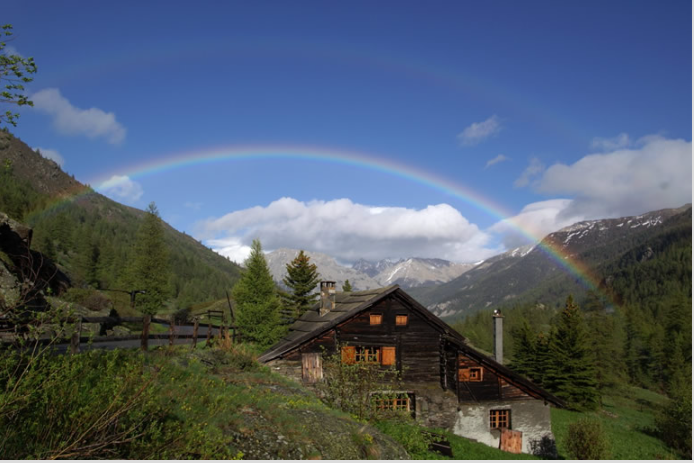Nevache, French Alps
Nevache, French Alps: A Spectacular Destination for Atmospheric Optics
Nestled in the picturesque French Alps, Nevache offers a breathtaking backdrop for observing atmospheric optics phenomena. This charming village has captivated the hearts of visitors with its stunning landscapes and awe-inspiring natural wonders. One such wonder is the mesmerizing display of rainbows that grace the sky, enchanting both locals and tourists alike. In this article, we delve deeper into the intricacies of rainbows in Nevache and explore the reasons behind their captivating beauty.
The Intensity Ratio of Primary and Secondary Bows
One striking feature of rainbows in Nevache is the well-defined intensity ratio between the primary and secondary bows. These bows are formed when sunlight undergoes refraction, reflection, and dispersion within raindrops suspended in the atmosphere. The primary bow is more vibrant and distinct, while the secondary bow appears fainter. This contrast is due to several factors that contribute to the unique characteristics of each bow.
The Formation of Primary and Secondary Bows
The primary bow is created by a single internal reflection within raindrops, resulting in a narrower width compared to its counterpart. On the other hand, the secondary bow requires two internal reflections, causing it to be wider and less intense. Additionally, the secondary bow undergoes an extra refraction that further diminishes its brightness. These combined factors contribute to the apparent disparity in intensity between the primary and secondary bows.
The Brightness Inside the Primary Bow
One intriguing aspect of rainbows in Nevache is the perception of a brighter sky inside the primary bow. This phenomenon occurs due to a process known as forward scattering. As sunlight enters the raindrop and undergoes refraction, a portion of the light scatters forward. This scattered light illuminates the region inside the primary bow, creating an illusion of increased brightness.
The Double Reflection within Raindrops
Another fascinating element of the secondary bow is the requirement of two internal reflections within raindrops. This double reflection causes the secondary bow to be wider and less prominent than the primary bow. The path of light within the raindrop is altered during each reflection, resulting in a broader dispersion of colors. Consequently, the secondary bow appears more diffuse and less vibrant compared to its primary counterpart.
Atmospheric Conditions and Rainbow Variations
The appearance of rainbows in Nevache can be influenced by various atmospheric conditions. Factors such as the size and shape of raindrops, the angle of sunlight, and the presence of other atmospheric particles can all contribute to the variations observed in rainbows. These factors affect the dispersion and refraction of light within the raindrops, leading to subtle differences in color intensity and bow shape.
Nevache: A Haven for Atmospheric Optics Enthusiasts
With its idyllic setting amidst the majestic French Alps, Nevache provides a haven for enthusiasts of atmospheric optics. The combination of stunning natural landscapes and favorable atmospheric conditions make it an ideal location for observing and capturing the beauty of rainbows. Visitors to Nevache have the opportunity to witness not only primary and secondary bows but also other atmospheric phenomena such as supernumerary bows, fogbows, and glory.
In conclusion, Nevache in the French Alps offers a captivating experience for those intrigued by atmospheric optics. The distinct intensity ratio between primary and secondary bows, the brightness inside the primary bow, and the double reflections within raindrops all contribute to the enchanting display of rainbows in this scenic destination. Whether you are a passionate photographer or simply an admirer of natural wonders, a visit to Nevache promises to leave you spellbound by the ethereal beauty of its atmospheric optics phenomena.

Rainbows in the French Alps
Imaged near Nevache by Alain Origne (Canigou atmospheric optics) on March 17, '07.
The intensity ratio of the primary and secondary bows is well shown. The secondary bow is fainter because it requires two reflections inside raindrops and because it is almost twice as wide as the primary.
Why is the sky brighter inside the primary?
Image ©Alain Origne, shown with permission.
Note: this article has been automatically converted from the old site and may not appear as intended. You can find the original article here.
Reference Atmospheric Optics
If you use any of the definitions, information, or data presented on Atmospheric Optics, please copy the link or reference below to properly credit us as the reference source. Thank you!
-
<a href="https://atoptics.co.uk/blog/nevache-french-alps/">Nevache, French Alps</a>
-
"Nevache, French Alps". Atmospheric Optics. Accessed on April 24, 2024. https://atoptics.co.uk/blog/nevache-french-alps/.
-
"Nevache, French Alps". Atmospheric Optics, https://atoptics.co.uk/blog/nevache-french-alps/. Accessed 24 April, 2024
-
Nevache, French Alps. Atmospheric Optics. Retrieved from https://atoptics.co.uk/blog/nevache-french-alps/.